When coloring soap, take these seven smart precautions: pre-mix colorants in appropriate carriers, wear respirator masks for powdered pigments, understand each colorant's properties, test small batches first, store in airtight containers away from light, account for color morphing in alkaline environments, and document your results. These simple steps prevent costly mistakes and disappointment while ensuring consistent, vibrant soaps. The difference between amateur and professional results often comes down to these careful preparation techniques.
7 Smart Precautions When Adding Colors to Soap
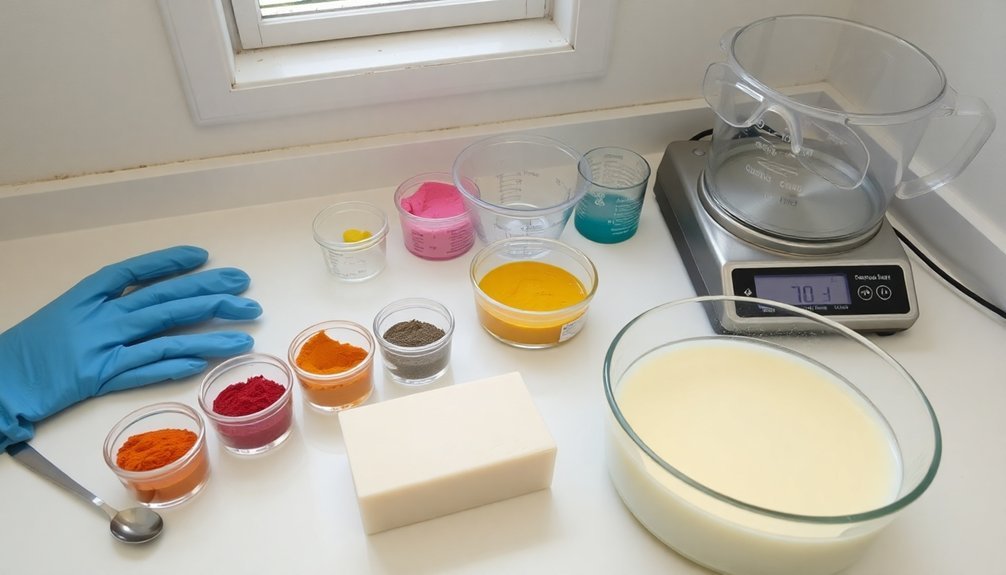
When adding colorants to your handcrafted soap, proper preparation prevents frustrating failures and guarantees vibrant, consistent results.
Always pre-mix your colorants in glycerin, oil, or water before adding color to your soap batch—this guarantees even dispersion and prevents clumping, especially with oxides and ultramarines.
Choose stable micas from reputable suppliers to minimize unexpected color changes during saponification.
When using titanium dioxide, apply it sparingly (maximum 1 tsp per cup) to avoid glycerin rivers if your soap overheats.
Remember that high pH environments can alter certain natural colorants, so ultramarine blue is your best bet for achieving true blue.
To maintain design integrity, select non-bleeding colorants and always test new options in small batches first before committing to a full production run.
Know Your Colorant Types and Their Properties
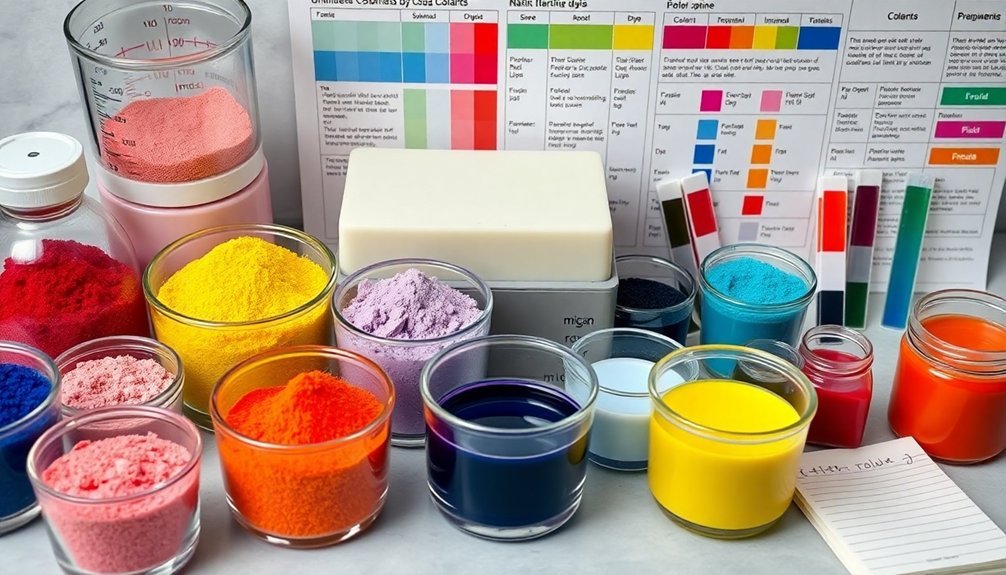
You'll need different mixing methods depending on your colorant type to prevent unsightly clumping in your finished soap.
Micas blend easily with a light whisking in oil before adding to your soap batter, while oxides and ultramarines require more thorough dispersion in oil using a mini-mixer or coffee frother.
For natural colorants like spirulina or alkanet root, consider steeping them in oil for 1-2 weeks before soapmaking to extract their color properly and avoid speckling.
Mixing Method Matters
Because each soap colorant behaves differently, your mixing method can make or break your final product.
Micas work best when mixed with lightweight oil, while pigments need thorough dispersion in oil or glycerin before adding to your soap batch.
For titanium dioxide, choose water-soluble varieties to prevent frustrating clumps.
If you're working with natural colorants like spirulina or turmeric, infuse them in oil or dissolve in water first to stabilize their colors and guarantee even distribution.
Lab Colors require special treatment—dilute them with distilled water and add a preservative, using approximately ½ mL per pound of soap.
When making cold process soap with pigments or micas, start with 1 teaspoon of properly dispersed colorant per pound of soap for ideal intensity.
Avoid Colorant Clumping
The frustrating sight of colorant clumps ruining your soap's appearance can be completely avoided with proper preparation techniques. Understanding each colorant's unique properties is essential for smooth dispersion.
Pre-mix micas with lightweight oils at a ratio of 1 teaspoon mica to 1 tablespoon oil to prevent clumping. For oxides and ultramarines, test their solubility first, then pre-mix with either oil or water before adding to your soap batch.
When working with titanium dioxide, opt for the water-soluble version rather than the oil-soluble form to minimize clumping issues.
Neons require mixing with recipe oil for seamless integration. Whatever colorant you're using, keep a mini frother handy—it's excellent for breaking up any unexpected clumps that form, ensuring even distribution throughout your soap.
Wear Protective Gear When Handling Powdered Colorants
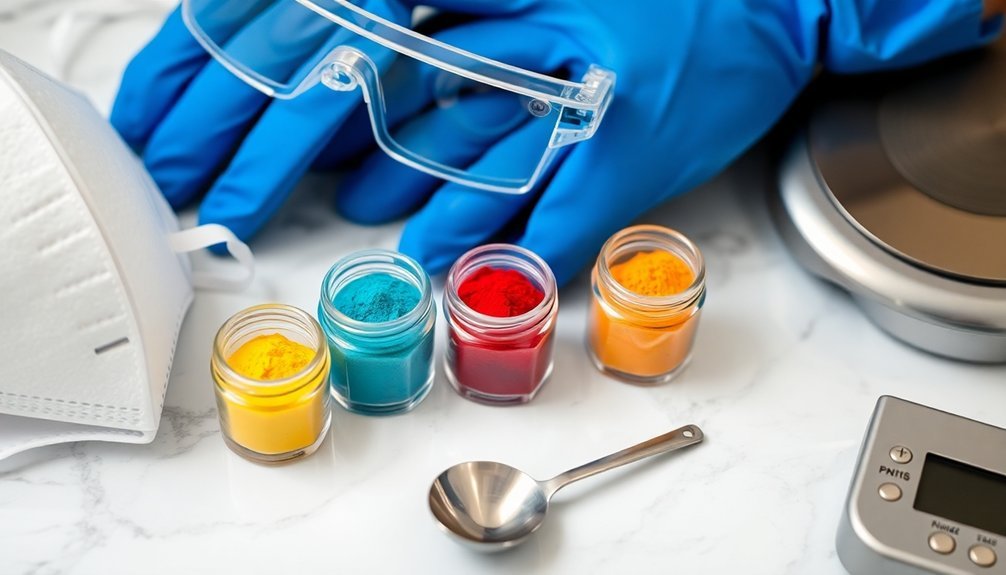
Respirator masks with replaceable cartridges are essential when working with powdered soap colorants, as they'll protect your lungs from harmful particles and VOCs that become airborne during mixing.
You're risking serious respiratory issues if you don't filter these microscopic colorant particles that can easily travel deep into your airways.
Make sure your mask fits properly and check the cartridges regularly, replacing them as needed to maintain effective protection while you craft your colored soaps.
Respirator Masks Matter
While many soapmakers focus on the creative aspects of their craft, protecting your respiratory system should never be overlooked when working with powdered colorants. A quality respirator mask with replaceable cartridges is your first line of defense against airborne particles that can cause serious long-term health issues.
When mixing colorants, opt for a full face shield respirator that safeguards both your lungs and face, especially when working with products releasing VOCs.
Don't forget to change cartridges regularly to maintain peak filtration efficiency during your soapmaking sessions.
Enhance your workspace air quality by installing a fan exhaust system or air purifier. This additional precaution creates a safer environment by reducing airborne colorant particles and minimizing potential respiratory hazards in your creative space.
Avoid Colorant Inhalation
Protecting your lungs begins with proper handling of powdered colorants, which pose significant inhalation risks if mismanaged.
Always wear a respirator with replaceable cartridges designed to filter out both particles and VOCs released during your soapmaking process. For maximum protection, consider a full face shield respirator that safeguards both your respiratory system and face.
Don't forget your safety goggles when working with powdered ingredients – they're essential for preventing eye exposure to colorant particles.
Improve your workspace's air quality by installing a fan exhaust system or air purifier to reduce airborne colorant concentration.
Remember to regularly inspect and replace your personal protective gear. Worn-out gloves or expired respirator cartridges won't provide adequate protection, potentially exposing you to harmful colorants that can damage your respiratory system.
Pre-Mix Colorants to Prevent Clumping and Speckles
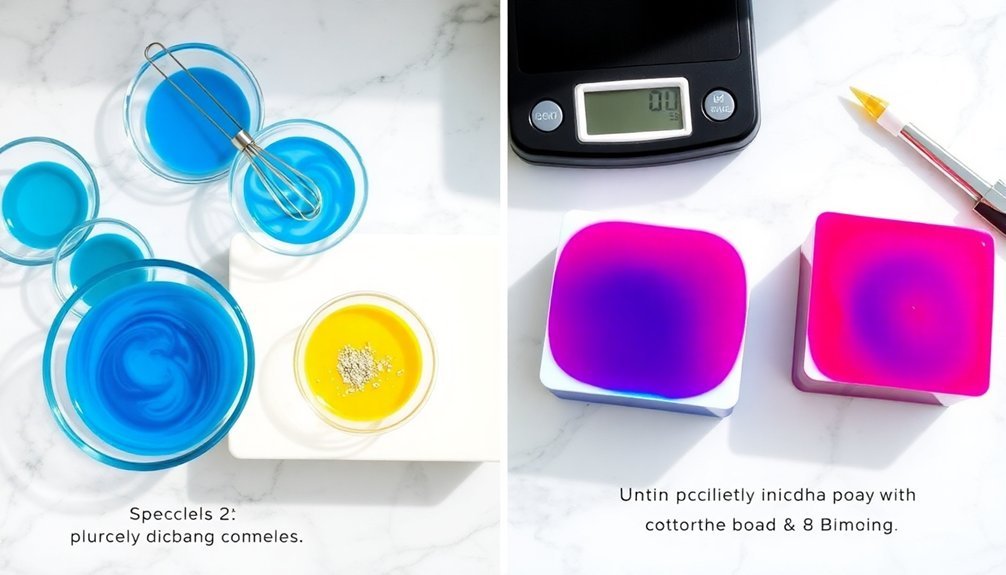
To achieve a flawlessly smooth and professional finish in your soap, you'll need to pre-mix your colorants before adding them to your soap batter. This essential pre-mixing step guarantees uniform dispersion throughout your final product, preventing unsightly clumps and speckles that can diminish your soap's visual appeal.
For micas, blend 1 teaspoon with 1 tablespoon of lightweight oil. When working with oxides and ultramarines, test whether water or oil provides better blending results for your specific formulation.
A mini frother is an excellent tool for eliminating stubborn color clumps during the mixing process.
If you're using titanium dioxide, choose the water-soluble version rather than the oil-soluble variant, as it's less prone to clumping issues during incorporation.
This careful preparation will elevate your soap's aesthetic quality.
Test Small Batches Before Full Production
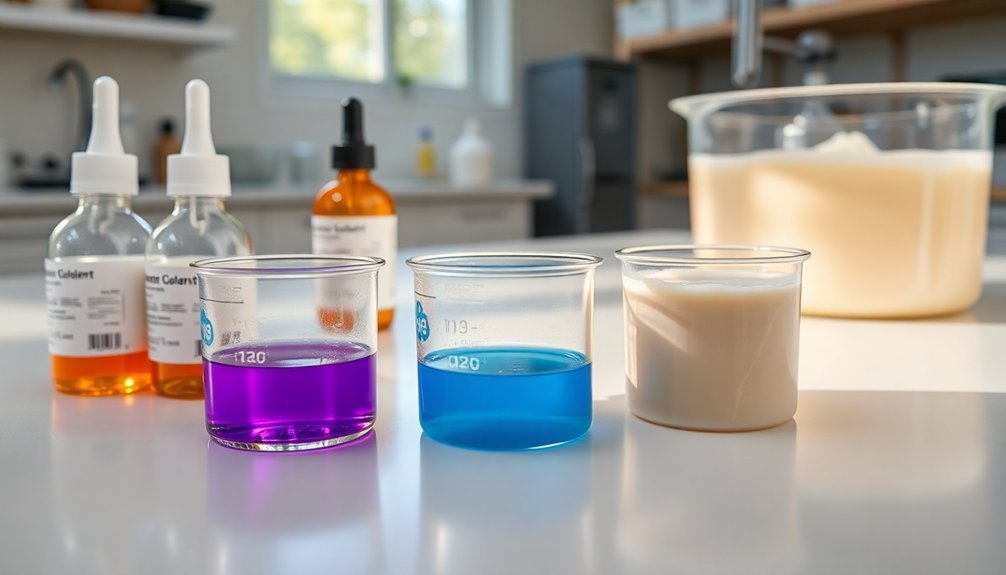
Beyond pre-mixing your colorants, smart soapmakers always test their formulations in small batches before scaling up to full production. This practice allows you to assess color stability and performance without wasting materials and time.
Start with 1 tsp of mica per cup of soap (or 1/4 tsp for oxides) to determine your ideal hue. Mix colorants with a small amount of glycerin or oil to evaluate dispersion quality and final appearance.
| Test Parameter | What to Monitor | Why It Matters |
|---|---|---|
| Temperature | Color shifts | Affects stability during saponification |
| Additives | Interactions | Can enhance or diminish colorants |
| Time | Color changes | Reveals long-term stability |
Don't forget to document results thoroughly, noting intensity levels and any changes over time. Your test notes will become invaluable references for future larger productions.
Store Colorants Properly to Maintain Potency and Safety
Proper storage of your soap colorants greatly impacts both their longevity and performance in your final products. Always keep your colorants in airtight containers to prevent moisture absorption that leads to clumping and reduced potency.
Store colorants in cool, dark locations, as light exposure can degrade their vibrant hues over time.
Label each container with the colorant type, purchase date, and handling instructions to prevent costly mistakes. For moisture-sensitive colorants, consider adding desiccants to your storage containers to extend shelf life and preserve quality.
Regularly inspect your inventory, discarding any colorants showing signs of spoilage such as texture changes, color shifts, or unusual odors.
These simple storage practices guarantee both the safety of your products and consistent coloring results in every batch.
Account for Color Morphing in Alkaline Environments
When working with colorants in soap making, you'll need to understand how the alkaline environment created by lye affects your chosen hues. Many dyes formulated for acidic conditions will transform unexpectedly when mixed into your high pH soap batter.
For a true blue color, reach for ultramarine blue, as other blue colorants often shift to purple or gray when exposed to lye solution. Natural colorants like spirulina maintain greener tones when added directly to lye water, while others may dramatically change appearance.
Always test your colorants for stability in alkaline environments before committing to a full batch. Being mindful of your soap's pH level throughout the process will help you select colorants that maintain their intended appearance during curing.
This simple precaution can save you from disappointment when your soap's final color emerges.
Frequently Asked Questions
How Do You Color Soap Safely?
To color soap safely, you'll need to pre-mix colorants with glycerin, use recommended amounts, test stability, wear protective gear like goggles and gloves, and consider titanium dioxide to prevent discoloration in your creations.
What Are the Safety Precautions for Soap Making?
You'll need safety goggles, nitrile gloves, and good ventilation when making soap. Always handle lye carefully, keep a first aid kit nearby, and follow SDS guidelines for all ingredients you're using.
Is It Safe to Put Food Coloring in Soap?
No, it's not safe to put food coloring in soap. You shouldn't use it as it can cause skin irritation, fade quickly, and isn't regulated for skin contact. Choose cosmetic-grade colorants instead.
What Precautions Should Be Taken When Making Liquid Soap?
When making liquid soap, you'll need to wear gloves and goggles, handle lye carefully, work in a ventilated area, keep children away, and measure ingredients precisely. Don't rush the process or skip safety steps.
In Summary
As you've learned, adding colors to your soap requires thoughtful preparation. Don't rush the process—test small batches, understand your colorants, and always wear protective gear when working with powders. Remember to pre-mix thoroughly to avoid those frustrating speckles, store properly, and anticipate color morphing in alkaline environments. With these precautions, you'll create beautifully colored soaps that are both safe and visually stunning.

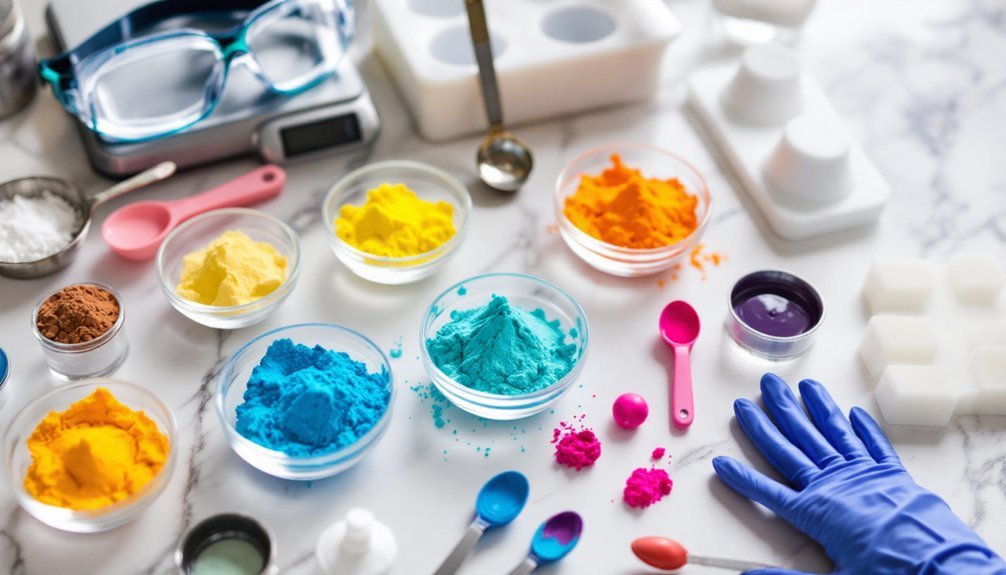



Leave a Reply